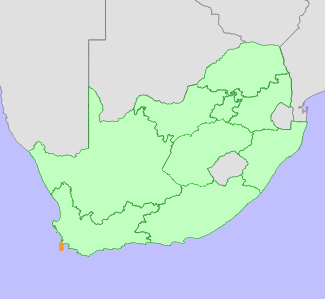It is known from between four and six extant subpopulations, the largest subpopulations occur within the Cape Point section of Table Mountain National Park with subpopulations numbering several hundred mature individuals occurring at Bonteberg and Olifantsbos. Smaller subpopulations of fewer than 100 plants occur within this same Cape Point location at Anvil Rocks, and Kommetieberg. Two small subpopulations occur on the mountains between Kommetjie and Simon�s Town, these are Rooikrans where the subpopulation consists of 20-30 plants and another on Manelkofkop which may be extinct as three plants were last recorded here in 2008. Other historically recorded subpopulations that have gone extinct are from Slangkop last recorded in 1950 and Tuinkop last recorded in 1971. The population is suspected to be declining slowly as a result of too frequent fires.
|
Goldblatt, P. and Manning, J.C. 2000. Cape Plants: A conspectus of the Cape Flora of South Africa. Strelitzia 9. National Botanical Institute, Cape Town.
Helme, N.A. and Trinder-Smith, T.H. 2006. The endemic flora of the Cape Peninsula, South Africa. South African Journal of Botany 72(2):205-210.
Hilton-Taylor, C. 1996. Red data list of southern African plants. Strelitzia 4. South African National Botanical Institute, Pretoria.
Raimondo, D., von Staden, L., Foden, W., Victor, J.E., Helme, N.A., Turner, R.C., Kamundi, D.A. and Manyama, P.A. 2009. Red List of South African Plants. Strelitzia 25. South African National Biodiversity Institute, Pretoria.
Rebelo, T. 2001. Sasol Proteas: A field guide to the proteas of southern Africa. (2nd ed.). Fernwood Press, Vlaeberg, Cape Town.
|
 Comment on this assessment
Comment on this assessment

